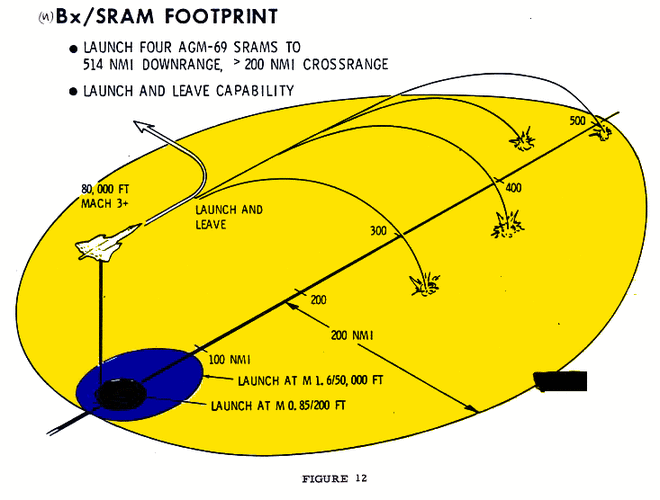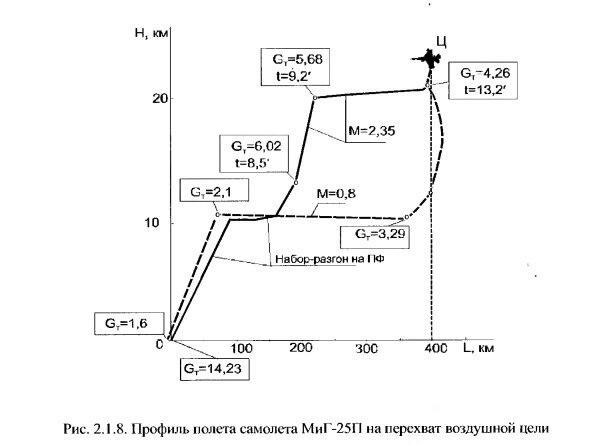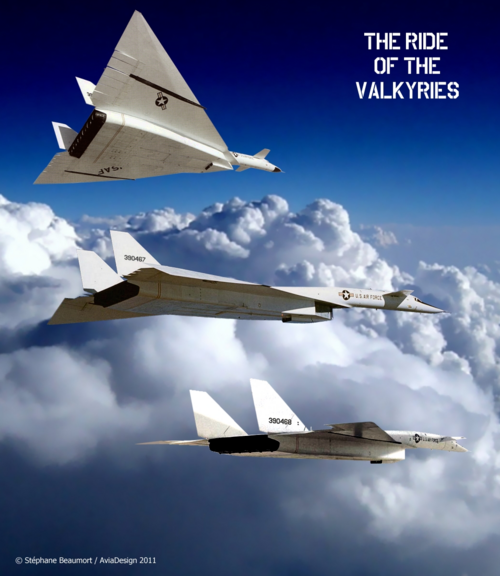In 1946 the main weapon of the Strategic Air Command (SAC) was the Boeing B-29 bomber, but this model reached the obsolescence when 57 Superfortress were destroyed by MiG-15 Soviet fighters during the Korean War.
In 1947 the USAF memorandum ‘Global Strategy Concept’ calling for a new intercontinental bomber able to perform nuclear attacks against the Soviet Union if the Red Army invaded Western Europe.
In June 1948, the Convair B-36, a 410,600 pounds (186,000 kg) heavy bomber entered in service. It tripled the gross weight of the B-29 and was able to carry two Mark III atomic bombs and had 8,000 miles (12,900 km) of range.
At the time, the main Soviet air defense radar was the American-supplied SCR-270 which were only effective up to 39,360 ft (12,000 m) and the main Sovietinterceptor was the Lavochkin La-9 with 35,400 ft (10,792 m) service ceiling.
The B-36 proved that it could fly at 40,000 ft (12,195 m) over the Soviet air space without being intercepted and the Truman Administration ordered the construction of 386 machines under the Cold War policy of nuclear deterrence.
Unfortunately for the SAC the Soviet fighter MiG-15A, with 50,840 ft (15,500 m) ceiling was delivered to operational units early 1949, followed by the MiG-17 (15,850 m) late in 1953, the MiG-19S (17,900 m) and the MiG-19 PM (17,000 m) armed with four K-5MS Akali air-to-air missiles in 1957. The B-36 served for only ten years.
In 1955 the USAF issued the specification GOR No. 48 calling for a supersonic bomber, with 6,000 miles range, to penetrate the Soviet air defense system. Six months later, the company North American Aviation Inc. proposed a six-engine canard-delta aircraft capable of cruising at Mach 3+ while flying at 70,000 ft (21,341 m).
It was expected that the new bomber would practically be immune to the cannon-armed Soviet interceptors, but it had also been planned to install a five-element defensive system embodying active and passive warning devices to be capable of noise jamming 30 Soviet radars operating simultaneously, threat evaluation equipment, electronic countermeasures, infrared countermeasures as chaff dispersing rockets and plastic smoke to screen the engine exhaust.
In August 1958, the proposal had been approved by the USAF under the codename Weapons System 110A and was expected to enter service in 1963 as the B-70 Valkyrie.
On February 26, 1955, the Soviet CPSU Central Committee ordered the development of weapons system Uragan-5, for the automatic guidance interception of enemy supersonic bombers flying at 82,000 ft (25,000 m) and 1,234 mph (2,000 kph).
The system was to be formed by 59 early warning ground radar stations with P-14(5N84A) Tall King VHF radar sets and 400 km of detection range, digital control computer, IFF interrogation system, command data link and a point-defense interceptor with 120 km combat range fitted with TsKB Almaz fire-control radar.
On March 7, 1957, the Mikoyan-Gurevich bureau was charged with the design of the new interceptor, under the codename Ye-150. The prototype was flown on July 8, 1960 reaching a top speed of 2,816 kph (Mach 2.65) and 73,000 ft (22,500 m) ceiling.
The combat version Ye-152-1 was flown on May 16, 1961 reaching Mach 2.28 armed with two underwing air-to-air missiles MKB Raduga K-9-51.
On July 7, 1962, the aircraft established the absolute speed record flying at 1,666 mph (2,681 kph) under the fictitious designation Ye-166.
The K-9 (NATO AA-4 Awl) was a beam-riding air-to-air missile with 5.6 miles (9 km) operational range, 3,130 mph (5,040 kph) top speed and only 55 per cent estimated accuracy because its GOS guidance system was vulnerable to the electronic countermeasures of the SAC bombers.
In 1959 entered service the first Soviet strategic air defense system, deployed around Moscow with 56 launch sites of SA-1 Guild surface-to-air missiles.
The SA-1 had Mach 2.5 top speed, 23 miles (37 km) range, 60,000 ft (18,300 m) operational ceiling and high explosive warhead with 120 ft kill ratios. Their B-200 guidance system was type track-while-scan.
The new surface-to-air missile SA-2 Guideline was deployed in 600 launch sites around the Soviet Union between 1960 and 1964.
The SA-2 had Mach 4 top speed, 21.7 miles (35 km) range, 131,200 ft (40,000 m) ceiling and high explosive warhead with 200 ft kill ratio. Their VHF guidance system P-12 Spoon Rest was type semi-active radar command.
On May 1, 1960 six MiG-19 fighters failed when trying to intercept a high-altitude reconnaissance U-2 piloted by Gary Powers, but the spy plane was shot down little afterwards by two SA-2.
By 1964 the Soviets already possessed small nuclear warheads capable of extending the kill ratio of the SA-2 to 19,680 ft and the ceiling to 80,000 ft.
The Valkyrie program suffered numerous delays due to inexperience with the new heat-resistant materials, as well as political and budgetary reasons. When the prototype XB-70 AV-1 was flown on September 21, 1964 the Soviet air defense system was already so consolidated that the WS110A specification was meaningless and the B-70 was cancelled by the Kennedy Administration.
In August 1958, the North American project office submitted the proposal Defensive Antimissile System (DAMS) using air-to-air missiles launched by the Valkyrie.
The Defense Feasibility Study was completed in March 1959 and published by the Air Proving Ground Center-Eglin AFB the same month the U-2 incident occurred.
In 1948 the first experimental AAM-A-2 air-to-air missile was launched and entered in service with the USAF in 1955 as the Hughes AIM-4 Falcon.
The original purpose of the Falcon was a Mach 3.8 self-defense weapon for the B-52 bomber and was shortly revived during the B-70 development. The rail-launched missile was not a particularly maneuverable and needed to be pointed in the right direction of the target.
Due to the B-70 speed the Falcon could just be used against any threat coming from its forward hemisphere, but the Valkyrie would have to defend itself against threats from all direction with spherical coverage.
The Falcon was a cylindrical rocket with four delta wings. Would it have been thrown sideways from a B-70 flying to Mach 3 it would have been destroyed by the crosswind shock waves.
North American proposed the Weapons System WS-740A, a wingless lenticular-form rocket with omnidirectional launch capabilities, capable of engaging incoming missiles at relative speeds of Mach 10 and being able to survive and maneuver at 250g accelerations.
The project was awarded to the Convair Division of General Dynamics Corporation, under the codename Pye Wacket in June 1959.
A general aerodynamic evaluation was conducted to determine the technical feasibility of lenticular cross section/circular planform configuration. Wind tunnel tests with several 1/3 scale models were conducted in the Arnold Engineering Development Centre.
The results indicated that the lenticular configuration with blunted trailing edge, sharp leading edge and modified tangent contours, have best aerodynamic characteristics than the symmetrical lenticular cross section, and the most desirable volume distribution for the propulsion system.
The lenticular configuration was efficient at hypersonic velocities with good maneuverability at altitude. Additional tests demonstrated that the aerodynamic controls are not suitable for use in the omnidirectional launch phase of flight, due to the necessity of alignment with the relative wind.
One reaction-jet control system was used, control in yaw, roll and pitch could be obtained by means of the thrust forces generated by four nitrogen-injected binary thrusters, with exhaust through the top and bottom surfaces of the disc.
Pye Wacket had an inertial midcourse guidance system with terminal infrared homing. The Redeye IR seeker was mounted in the leading edge behind an IR window with a look angle of 40 degrees and cooling system.
The USAF determined that internal carriage of eight wingless missiles could be installed in the Valkyrie with no range penalty.
The weapon was to be structurally rigid to withstand extremely high launch accelerations, rapid change of thrust direction for quick maneuver, maximum flight duration of 50 seconds, cruising at Mach 6.5+ and terminal velocities of Mach 10.
The expected aerodynamic heating of 3,300 ºF at 11 seconds of flight, requires the use of a leading edge made of Pyrographite. The outer skin of the disc was made of polyester resin, with Titanium B-120 alloy honeycomb core, protected by a layer of Teflon ablating material to restrict skin temperatures to under 800ºF. The internal structure was made of magnesium-alloy.
Three Pye Wacket configurations were proposed in 1961:
60-inch diameter, 21 per cent thickness-to-chord ratio configuration
Power plant: three Thiokol M58A2 solid-fuel rocket motors with 10,200 lbf thrust each. Launch weight: 830 pounds. Warhead: one W54 nuclear device with 50 pounds weight. Range: 100,000 ft at 60,000 ft altitude.
60-inch diameter, 14 per cent thickness-to-chord ratio configuration
Power plant: one integral pancake-shaped solid-fuel rocket motor with 9,700 lbf thrust. Launch weight: 581 pounds. Warhead: 20 pounds of H.E. with impact fuse. Range: 120,000 ft at 60,000 ft altitude.
36-inch diameter, 21 per cent thickness-to-chord ratio configuration
Power plant: one integral pancake-shaped solid-fuel rocket motor with 5,000 lbf thrust. Launch weight: 200 pounds. Warhead: 20 pounds of H.E. with impact fuse. Range: 50,000 ft at 60,000 ft altitude.




